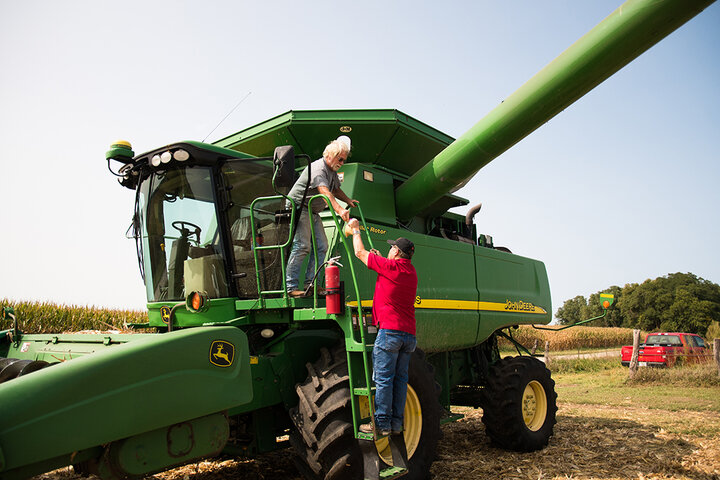Daryl Obermeyer of Brownville, Nebraska has always done his own research to improve practices on his operation.
When he went to a soybean board meeting and heard guest speaker Laura Thompson, with the On-Farm Research Network, talk about her research, he reached out.
“I wanted to get legitimate results, so I called the On-Farm Research Network and the NRCS,” Obermeyer said.
In this research project, Obermeyer was testing winterkill cover crops and spring burndown cover crops in an effort to improve soil health.
“Daryl has been an outstanding cooperator here in southeast Nebraska for this project,” said Nebraska Extension Water and Integrated Cropping Systems Educator Gary Lesoing.
Obermeyer Farms
Daryl Obermeyer has always been a self-starter, reaching back to when he first bought the farm.
This first-generation farmer has a diversified operation where he grows soybeans, wheat, corn, alfalfa and raises cattle. He has been working the land for 50 years. He and his wife Jackie have been married for 49 years and have three kids. The future of Obermeyer farm is bright as they have six granddaughters. Currently, there are two granddaughters who are interesting in taking over the farm and becoming second-generation farmers.

Water Infiltration is Key
One way that Obermeyer has been able to improve the bottom line is through planting cover crops like cereal rye, turnips and radishes. For this study, he compared that mixture to a mixture of oats, turnips and radishes. He saw that with a live root always in the soil, there was greater water infiltration.
This is an outcome that Obermeyer had been suspecting before inviting On-Farm Research in on the study. He has also seen an increase in organic matter, as expected by utilizing cover crops.
“I really didn’t have any expectations for this study, I was just waiting for results,” Obermeyer said.

All About the Results
Lesoing reported this about Obermeyer’s study: “The first and second years of the project, winter-hardy cover crops (cereal rye) used more moisture in the soil profile than the winter-killed cover crops of oats in the corn and soybean crops respectively.
“This was just the first two years of the study and on the poorer soil. The final three years of the study, yields were excellent and comparable for corn and soybeans following winter hardy and winter terminated cover crops each year.”
Cattle and Cover Crops
This cover crop study proved to be useful to his cattle operation in many ways. One of those ways was savings in hay and mineral by grazing the cattle on the cover crops.
“By grazing my cattle on the cover crops, I improved my herd health as seen by healthier calves,” Obermeyer said.
By doing this study with winterkill and spring burndown, he was able to graze cattle during a warm spring and in the fall. Overall, grazing cattle on these fields helped decrease his fertilizer costs. With all of these factors adding up, he was able to help improve the bottom line through cover cropping.

OFR Runs Deep on Obermeyer Farms
Obermeyer had already implemented cover cropping practices in his operation before the NRCS and On-Farm Research study started. He used this study to validate what he was doing and get concrete data and results of what was really happening.
“I just didn’t have the time or patience to run all the statistics,” Obermeyer reflected.

At the end of the study, it validated his management decision to plant cover crops due to the fact that it helped the bottom line and improved soil health.
Right now, Daryl is doing another study with Nitrogen Management and wheat, with this being year three of the study. He recommends doing a study to other producers who are looking to improve something on their operation or even just validate what practices they have already implemented on their operations.
“There are several opportunities to participate in specific on-Farm Research Projects, with some even providing financial compensation for participating in an experiment,” Lesoing said.
“Farmers can also design their own projects if they want.”
Contact a member of the team to get started with an On-Farm Research study of your own!
The Nebraska On-Farm Research Network is a collaborative partnership that includes Nebraska Extension, the Nebraska Corn Board, the Nebraska Corn Growers Association, the Nebraska Soybean Checkoff and the Nebraska Dry Bean Commission.

